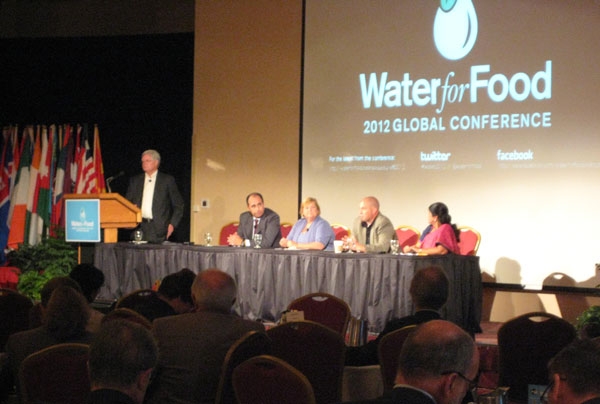Water for Food Conference speakers address issues of importance to Californians
The confluence of global climate change and population growth is brewing a “perfect storm” that threatens the availability of sufficient fresh water to grow food to feed the world by 2025, warned Colin Chartres, the director general of the International Water Management Institute in Sri Lanka.
Chartres spoke at the Water for Food Global Conference in Lincoln, Neb., May 30. More than 500 attendees from 28 countries on 6 continents have convened in Lincoln to address the challenges of food security in relation to water supplies. The conference continues through Saturday.
“We will have to feed 2 billion more people with less water than we now have in an era of climate change,” Chartres noted in his presentation. “How we deal with water scarcity over the next 10 to 20 years will have a fundamental impact on food security, poverty reduction and the environment in years to come.”
He offered four solutions for skirting this ”perfect storm”:
Healthier diet: Currently, producers grow food to provide about 2,800 to 3,000 calories per person per day, including 224 grams of meat. If people instead were to eat a healthier diet with much less meat (an average of about 90 grams), the world would realize water savings of 1,350 cubic kilometers. “By anybody’s standard, that’s a lot of water,” Chartes said.
Reduce waste. Currently, a tremendous amount of food is thrown away at the point of production and the point of consumption, representing a significant waste of water used in the food production.
Encourage trade. Grow water-hungry crops in water-rich areas. This concept is already driving geo-politics, Chartes said. Water-scarce countries are thinking about where to get their food in the future.
Increase productivity. Produce more crop per drop in irrigated and rain-fed agricultural systems.
The efforts of the Conservation Agriculture Systems Innovation (CASI) workgroup can play a role in preventing the “perfect storm” in California, the United State’s No. 1 ag producer. CASI’s research and education programs will allow farmers to grow more food with less water by helping them convert flood irrigation systems, currently used on 57 percent of the state’s cropland, to more water efficient irrigation systems, such as mechanized overhead and subsurface drip systems. Combining the efficient irrigation with conservation tillage saves still more water. CASI research has shown that systems with improved application efficiency can cut irrigation water requirements by 10 to 30 percent.
During the producer’s panel discussion at the Water for Food Conference, two American farmers – one from Nebraska, the other from Iowa – described their use of conservation tillage techniques and mechanized irrigation to increase farm efficiency.
Farmer Brandon Hunnicutt works 2,600 acres with his father and brother on a Nebraska farm that has been in the family for 100 years. He said they have made tremendous strides in reducing inputs – tillage, water, fertilizer and pesticides – using mechanized irrigation equipment, conservation tillage and Watermark soil moisture sensors. The sensors send information to a cellphone or tablet computer for real-time remote monitoring of the moisture being held in the soil.
“My uncle farms down the road. It was fun to watch them irrigate, when we held off,” Hunnicutt said. “We were saving water, saving electricity and wear and tear on the equipment. I was excited to see just how far we were able to go with less fertilizer and less water while maintaining yield.”
Farmer April Hemmes of Iowa said she believes precision farming techniques will be particularly important in the future. For example, on her farm, they have mapped all the soil and apply fertilizer at a variable rate.
“Those of us farming in the Missouri and Mississippi valleys have a target on us,” Hemmes said. “We are being blamed for the dead zone in the Gulf. (A region of oxygen-depleted water off the Louisiana and Texas coasts that is harmful to sea life.) We have to be far more precise with nutrients and manure management. I think in the future, that will play a lot in how we farm.”
CASI chair Jeff Mitchell, UC Cooperative Extension specialist in the Department of Plant Sciences at UC Davis, said the Water for Food Conference has provided an inspiring large-scale perspective on emerging global issues that people from around the world are working on.
“The insights and the projections for how and if water resources are going to be sufficiently managed to address the inevitable population changes are enormously important,” Mitchell said. “They will compel us to work even more assiduously on improved systems, on technology development and adoption of improved management practices.”
He complimented the University of Nebraska, Lincoln, sponsor of the Water for Food Conference, for the coordination of their initiatives to address global water issues and the success they have had in establishing the Water for Food Institute.
“It's striking to me optimism the University of Nebraska has,” Mitchell said. “The optimism is motivating to me personally.”

